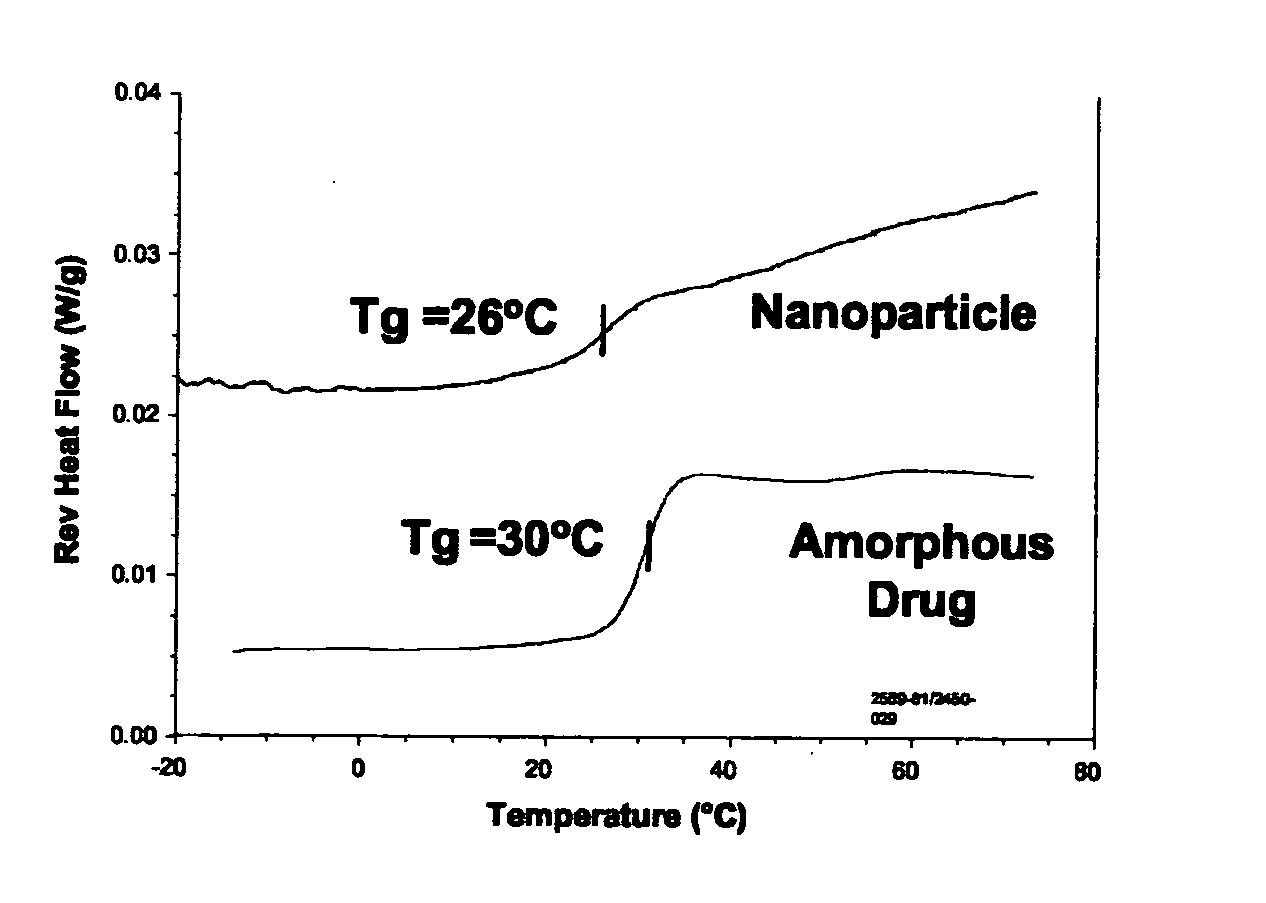Nanoparticles comprising non-crystalline drug
a non-crystalline drug and nanoparticle technology, applied in the direction of biocide, heterocyclic compound active ingredients, microcapsules, etc., can solve the problems of limited maximum drug loading, physical stability, difficult resuscitation, etc., to achieve good physical stability of non-crystalline drugs, high levels of free drugs, and greater bioavailability
- Summary
- Abstract
- Description
- Claims
- Application Information
AI Technical Summary
Benefits of technology
Problems solved by technology
Method used
Image
Examples
examples 1-3
[0084]Surface stabilized nanoparticles containing the CETP inhibitor [2R,4S] 4-[(3,5-bis-trifluoromethyl-benzyl)-methoxycarbonyl-amino]-2-ethyl-6-trifluoromethyl-3,4-dihydro-2H-quinoline-1-carboxylic acid ethyl ester (“Drug 1”, also known as torcetrapib) were prepared. Drug 1 has a Tg of 30° C., a Tm of 95° C., and a Log P of about 7.55. For the nanoparticles of Example 1, 150 mg torcetrapib and 150 mg of the phospholipid 1,2-diacylphosphatidylcholine (from egg yolk, Type XVI-E, approx. 99%, available from Sigma, St. Louis, Mo.) (“PPC”) were dissolved in 3 mLs methylene chloride to form an organic solution. Next, 18 mg of the bile salt sodium glycocholate (also available from Sigma) (“NaGC”) was dissolved in 34.5 mL deionized water to form an aqueous solution. The organic solution was then poured into the aqueous solution and emulsified for 3 minutes using a Kinematica Polytron 3100 rotor / stator at 10,000. rpm. The solution was further emulsified to reduce particle size using a Micr...
example 4
[0100]Surface stabilized nanoparticles containing the CETP inhibitor [2R,4S] 4-[acetyl-(3,5-bis-trifluoromethyl-benzyl)-amino]-2-ethyl-6-trifluoromethyl-3,4-dihydro-2H-quinoline-1-carboxylic acid isopropyl ester (“Drug 2”) were prepared as described above for Example 1. Drug 2 has a Tg of 45° C., a Tm of 111° C., and a Log P of about 7.55. The nanoparticle formulation of Example 4 contained Drug 2, PPC, and NaGC in a mass ratio of 8:8:1.
Isolation of Solid Nanoparticles
[0101]Spray-drying was used to isolate dried nanoparticles of the invention. Following evaporation of methylene chloride from the emulsion, 3.125 g trehalose was added to 62.5 g Example 4 nanoparticle solution. The solution was pumped into a “mini” spray-drying apparatus via a Cole Parmer 74900 series rate-controlling syringe pump at a rate of 6 ml / hr. The drug / polymer solution was atomized through a Spraying Systems Co. two-fluid nozzle, Model No. SU1A using a heated stream of nitrogen at a flow rate of 1 SCFM. The sp...
examples 5 and 6
[0103]Surface stabilized nanoparticles containing Drug 2 were prepared as described above for Example 1, with the exceptions noted in Table 5. The nanoparticle formulation of Example 5 contained Drug 2, PPC, and NaTC in a mass ratio of 1:2:1. The nanoparticle formulation of Example 6 contained Drug 2, PPC, and NaTC in a mass ratio of 8:8:1.
TABLE 5MethyleneRotaryDrug 2PPCChlorideNaTCWaterRotosatorHomogenizerEvaporationExample(mg)(mg)(mL)(mg)(mL)(min)(min)(min)512525051255055306100100212.5234not recorded30
[0104]The nanoparticles of Example 6 were characterized using DLS analysis, and had a cumulant size of 62 nm with a polydispersity of 0.13, following formation, and a size of 81 nm with a polydispersity of 0.36 24 hours after formation.
Concentration Enhancement
In Vitro Dissolution Tests
[0105]An in vitro dissolution test was used to determine the dissolution performance of the nanoparticles of Examples 5 and 6. For this test, a sufficient amount of material was added to a scintillatio...
PUM
| Property | Measurement | Unit |
|---|---|---|
| solubility | aaaaa | aaaaa |
| pH | aaaaa | aaaaa |
| size | aaaaa | aaaaa |
Abstract
Description
Claims
Application Information
 Login to View More
Login to View More - R&D
- Intellectual Property
- Life Sciences
- Materials
- Tech Scout
- Unparalleled Data Quality
- Higher Quality Content
- 60% Fewer Hallucinations
Browse by: Latest US Patents, China's latest patents, Technical Efficacy Thesaurus, Application Domain, Technology Topic, Popular Technical Reports.
© 2025 PatSnap. All rights reserved.Legal|Privacy policy|Modern Slavery Act Transparency Statement|Sitemap|About US| Contact US: help@patsnap.com


